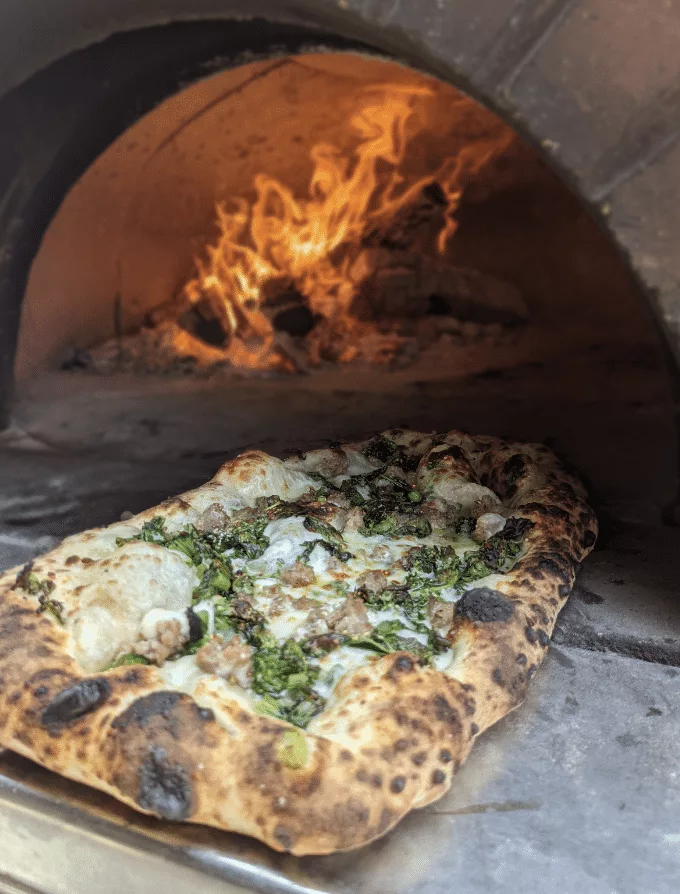
Oven-fired pizza
Oven-fired pizza, with its perfectly crisp crust and bubbling, golden cheese, has become a beloved food around the world. Its origins can be traced back to ancient civilizations, and its journey from humble beginnings to modern-day culinary icon is a fascinating tale of cultural exchange and culinary innovation. In this blog post, we will explore the captivating history of oven-fired pizza, delving into its early beginnings, the emergence of the iconic Margherita pizza, and the global spread of this delectable dish.
Ian Alexander, CC BY-SA 4.0 https://creativecommons.org/licenses/by-sa/4.0, via Wikimedia Commons
The Early Beginnings of Flatbreads:
To understand the history of oven-fired pizza, we must first examine the origins of flatbreads, the precursor to the modern pizza crust. Flatbreads have been a staple in many cultures throughout history, dating back thousands of years. Ancient Egyptians, Greeks, and Romans all had their own versions of flatbreads, often using them as edible plates to hold other foods.
The concept of flatbreads topped with various ingredients likely originated in the Middle East, where simple pieces of bread were adorned with olive oil, herbs, and spices. As these pieces of bread made their way to the Mediterranean region, they became a popular and accessible food option for people of all social classes.
(Photo) Civica Raccolta delle Stampe « Achille Bertarelli » 1830, Public domain, via Wikimedia Commons
The Birth of Pizza in Naples, Italy:
While flatbreads with toppings can be traced back to numerous ancient cultures, the dish we recognize as pizza today has its roots in Naples, Italy. Naples, a bustling port city, was known for its diverse population and vibrant street food culture in the 18th and 19th centuries. It was here that the simple flatbread began to evolve into the pizza we know and love.
Neapolitan pizzaiolos, or pizza makers, would create their dough from a mixture of water, yeast, salt, and local wheat flour. The dough would be stretched by hand, then topped with ingredients like tomatoes, cheese, olive oil, and garlic. These early pizzas were cooked quickly in wood-fired ovens, resulting in a perfectly crisp, slightly charred crust.
The Margherita Pizza: A Royal Creation:
One of the most famous and enduring pizza varieties is the Margherita pizza, a simple but delicious combination of tomatoes, mozzarella cheese, and fresh basil. The story behind the creation of this iconic pizza is a fascinating slice of culinary history.
In 1889, Queen Margherita of Savoy, the queen consort of Italy, visited Naples with her husband, King Umberto I. To honor her visit, a local pizzaiolo named Raffaele Esposito created a special pizza featuring the colors of the Italian flag: red tomatoes, white mozzarella cheese, and green basil leaves. The queen was so delighted by the dish that she sent Esposito a letter of thanks, and the Margherita pizza was born.
This royal endorsement solidified the Margherita pizza’s place in Italian culinary history and helped to establish the reputation of Neapolitan pizza as a dish of exceptional quality and flavor.

The Global Spread of Pizza:
The late 19th and early 20th centuries saw a wave of Italian immigration to the United States and other parts of the world. These immigrants brought with them their culinary traditions, including the art of pizza making. As Italian communities grew in cities like New York, Chicago, and Buenos Aires, so too did the demand for authentic, oven-fired pizza.
In the United States, pizza quickly gained popularity as an affordable and delicious food option. Pizzerias began to open in major cities, with each region putting its own spin on the classic Neapolitan pizza. New York-style pizza, known for its thin, foldable crust, and Chicago-style deep-dish pizza, characterized by its thick, buttery crust and layers of toppings, are just two examples of the regional variations that emerged in response to local tastes and preferences.
As the 20th century progressed, pizza continued to spread across the globe, finding its way to countries like Australia, Japan, and Brazil. Each new destination adapted the classic oven-fired pizza to incorporate local ingredients and flavors, resulting in a diverse array of pizza styles and toppings.
Wood-Fired Ovens: The Traditional Way to Cook Pizza:
Throughout pizza’s long history, the use of wood-fired ovens has remained a constant. Traditional Neapolitan pizza, in particular, is known for its distinctive charred crust and smoky flavor, both of which are achieved through the use of a wood-fired oven.
Wood-fired ovens are designed to cook pizza quickly at extremely high temperatures, typically ranging from 800 to 1,000 degrees Fahrenheit. This rapid cooking process results in a perfectly crisp crust and a deliciously melted, bubbly cheese topping. The use of wood as fuel also imparts a subtle smokiness to the pizza, adding an extra layer of depth and flavor.
In recent years, there has been a resurgence of interest in traditional wood-fired pizza ovens, both in restaurants and for home use. This renewed appreciation for time-honored cooking techniques is a testament to the enduring appeal of oven-fired pizza.

Modern Innovations and the Future of Oven-Fired Pizza:
As pizza has spread across the globe, so too has the spirit of culinary innovation that has long defined this beloved dish. New technologies, such as electric and gas pizza ovens, have made it easier than ever to achieve restaurant-quality pizza at home. These modern appliances offer precise temperature control and the ability to cook pizza quickly and evenly, ensuring a perfect crust and topping every time.
In addition to technological advancements, the world of pizza has also seen a surge of creativity in terms of toppings and flavor combinations. From sushi-inspired pizzas in Japan to gourmet, artisanal creations featuring ingredients like truffle oil and goat cheese, pizza continues to evolve and adapt to the tastes and preferences of its global audience.
Despite these modern innovations, the heart and soul of pizza remain rooted in the traditional techniques and ingredients that have defined the dish for centuries. As the culinary landscape continues to change and grow, there is no doubt that oven-fired pizza will remain a beloved and enduring classic for generations to come.

The history of oven-fired pizza is a fascinating journey that spans continents, cultures, and centuries. From its humble beginnings as a simple flatbread in ancient civilizations to its evolution into the delicious, diverse dish we know today, pizza has captured the hearts and taste buds of food lovers around the world.
As we look to the future, the enduring popularity of oven-fired pizza is a testament to the power of culinary tradition and the universal appeal of a perfectly cooked, mouthwatering slice. So the next time you savor a piece of oven-fired pizza, take a moment to appreciate the rich, delicious history behind every bite.







